Facebook, LinkedIn and “the like” are social media platforms. The media reference is appropriate, even if they didn’t choose that name for themselves. They are a digital form of traditional television, based on networks that serve up content for “free.” But free means that they are supported by advertising revenue. Viewers provide eyeballs and attention in exchange for content. In that sense, there is nothing new about social networks. But, because they are addressable in ways television has only dreamed of being, social networks could set up a different time of revenue stream altogether. They could offer up work opportunities, personalized precisely based on member interest and behaviors — data they have in troves that is currently used to overload us with advertising. When they could use that information to help us do more, even address the declining productivity economists are trying to understand. (See articles in The Atlantic, WSJ, The New York Times.)
What if social networks became platforms that expose us to opportunities to do work, as well as serving up content and, yes, even advertising?
“Running through history … is this tendency to divide labor on a big scale; everybody in this habit of getting other people to do things for us and doing things for other people. Working for each other is the great theme of human history. Comes about through exchange in a local way; and through trade on a wider scale.”
“Working for each other is the great theme of human history.” We seem to have forgotten Mr. Ridley’s truth here in the age of social networking. “Working for each other” requires exchange. And what makes humans unique among earthly creatures is the capacity to exchange dissimilar goods or services. Thanks to communication, there is a capacity to negotiate, to agree on the equitable values on both sides of the exchange. Human trade goes beyond mere reciprocity (of which there are some examples in the animal kingdom per Mr. Ridley).
We are social creatures, too. Look no further than the inflationary growth in social networks for evidence. And … we humans indeed enact exchanges in the age of social networks. Citizens of the social platforms share information with each other in Facebook and LinkedIn and Twitter and SnapChat, etc. And those exchanges on a personal or social level may indeed be reciprocal.
But on the social network/platform level the exchange is not reciprocal. Platform providers are taking far more than is acknowledged from those who share or “make.” Let there be no question here: In the social networks, members are “working for the man.” Platforms pull data, which is actionable and drives profits for the host. Platforms push advertising, which is the essential revenue stream. Free is not free. The cost of free is advertising, demanding more and more attention, taking advantage of members. Odd that there is so much opacity in a world so dependent on visibility. Toss in a little transparency, and we can start “working for each other.”
What If Social Networks Became Free Agent Marketplaces?
What if social networks offset the advertising burden on eyeballs with opportunities to do work? They could become free agent marketplaces alongside all that sharing, in sync with the growing trends in the world of work.
Today, social networks of sharing are foundational in the “attention economy.” Free is paid for with “eyeballs.” Exchanges, certainly of the monetary kind, are one way.

The platforms are transactional – in terms of monetary value – in one direction, to the platform hosts. To some degree, there is participation without compensation. More to come on that matter.
Tim Wu ( @superwuster ) laments this “attention” economy — which is fundamentally a one-way “trade” that benefits the host. Jaron Lanier skewers this one-way model, too.
Doc Searls (co-author of the seminal Cluetrain Manifesto and author of The Intention Economy @dsearls ) lobbies actively for the Intention Economy, which is fundamentally a two-way “exchange” that benefits both sides of the equation in a more reciprocal way. In his view, if companies can manage the customer relationship (CRM), then customers should be able to manage the vendor relationship (VRM) and ALL the data that goes with it.
Tomorrow’s social networks of doing could be foundational in an “intention economy.” Free is paid for with opportunity. Exchanges, certainly of the monetary kind, would be two-way.

Wouldn’t a two-way scenario be more equitable? More sustainable? More true to what makes us human – per Mr. Ridley.
Sure, advertising can and will still play a role in generating revenue. (Even the most elevated of hosts won’t give up/back all that advertising revenue.) But why couldn’t opportunities for work be exposed to those same eyeballs? And why couldn’t the member – now in more a active capacity – be able to choose the form of compensation, including cash or its equivalents?
But wait. Aren’t users/members compensated now? Yes, but only in ways that make the hosts fabulously wealthy. (Facebook market cap grew at a 175% rate over 3 years. John Battelle.)
What Are The Currencies Now And What Could They Become?
Members are compensated in the form of content (information, entertainment) in exchange for joining, sharing, updating, attending, clicking. We don’t think of those activities as work. But work is being done in the shadow of those activities. Members are essentially data factories, churning out information about likes, dislikes, interests, behaviors. It’s autonomous, like breathing. Members are the data robots of the social networks.

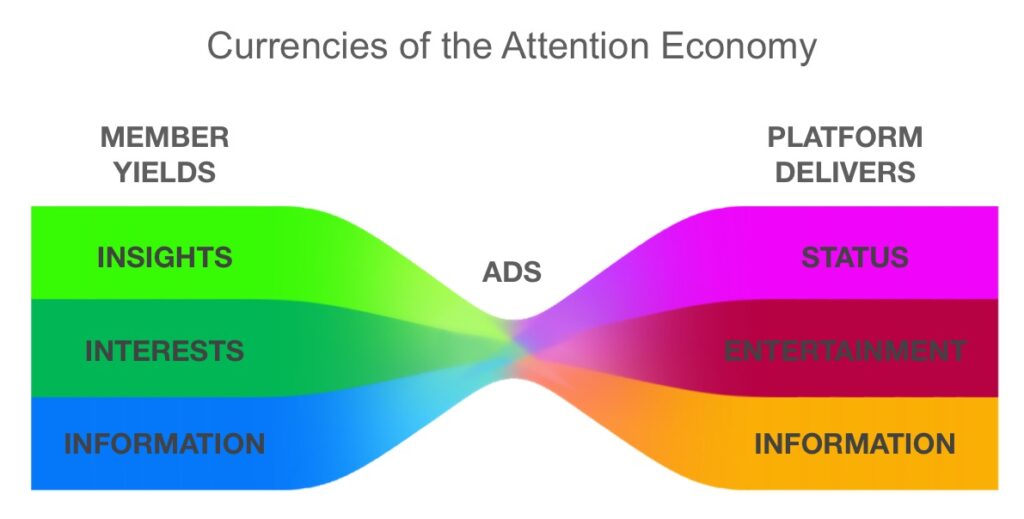
Third party companies (advertisers) mine that data, profiting themselves (ostensibly) and the platforms (obviously) to shape product development and brand messages and sales pitches back to platform members. Attention is the price of access to the platform, where members enjoy the content shared by peers and other content generators, while also being exposed to the relentless advertising feed.
Social networks serve up “take it or leave it” memberships.
Since one joins for “free,” the tacit agreement is that members tolerate, accept, attend to whatever serves the interests of the host. Of course, the host argues that what it serves up is filtered by a member’s profile. Members enter information, they share interests, their status, position, preferences, sentiments and more. The aggregate of these posts builds up a data mine that is researched and analyzed to discern insights that will shape further content that, yes, algorithmically reflects the members’ interests, as well as those of the platform and the advertisers. Endless loop. Vicious cycle. Established.
Members generate information, share interests and yield insights in exchange for information or entertainment, which are valuable content. They also accumulate status (not always as intended, perhaps), which amounts to a highly valued social currency. So there is, not to be doubted, a very real exchange happening in these networks. Again, on the horizontal peer-to-peer level, this exchange is essentially reciprocal.
Hear, Here: It is in the host-to-member vertical where reciprocity is shattered – the transaction is one-way, almost entirely to the benefit of the network host.
Transactions are take-it-or-leave-it exchanges. Members accept these terms by virtue of creating a free account. There is no negotiation. “Accepting the terms” is just how it is (as it is with so many other online access agreements — see Doc Searls blog post here).
Side Note: Yes, there are ad-blockers, but why should users be forced into a defensive posture? Because we are defending ourselves, our privacy, our data, the topic of consumer sovereignty is picking up steam. Doc Searls published (May 25, 2017, an essay on consumer sovereignty — referring to “consumertech”(VRM) vs “adtech,” “martech.” Cass Sunstein explores consumer soverignty in this EconTalk interview re his book #Republic.
Invite Social Networks To Embrace Negotiable, Compensatory Memberships
Compare the Attention Economy and the Intention Economy. One greatly favors the host over the member, while the other rewards both. Eyeballs are engaged in both. The Intention Economy gives power back to the member – as spec’d by Doc Searls – and balances the playing field.
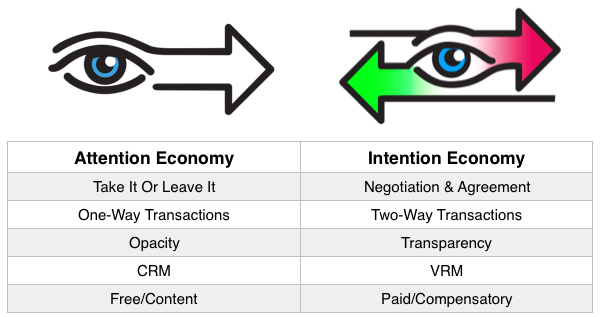
Engage Idle Capacities In The Social Network To Become Producers, Not Just Consumers.
The contention of this article is that the platform hosts have side-stepped entirely another way to leverage the network, its membership and the data generated. What they have side-stepped is the notion of doing purposeful work, targeted to appropriate members and then compensating those members for the product of their labor. Set up an alternative revenue stream – work – and reduce the pressure on eyeballs to attend to the burgeoning tsunami of advertising. And awaken an entire world of productivity in the process.
Replicate the investment and technology applied to filtering preferences for the purpose of serving up advertising and serve up – to those same appropriate eyeballs – opportunities for work and compensation. To the work done passively, add work to be done actively. Invite ideas and solutions to problems. Offer up outright tasks. The network charges the “employer” for the posting based on the ask. The network builds a margin into that fee, as well as compensation to the member for work performed. To the currencies of content and status, add experience and cash equivalents.
Opportunities may be engaged on a first-come-first served basis. It may be a “crowdsource-like” opportunity, which likely embraces some sort of competitive elements. The opportunity could be narrowly or broadly targeted, based on the information the social network already has (or expands upon) about the member. Task and terms must be transparent and complete from the outset. Proven mechanisms for effectively handling distributed challenges can be adopted/adapted to this scenario.
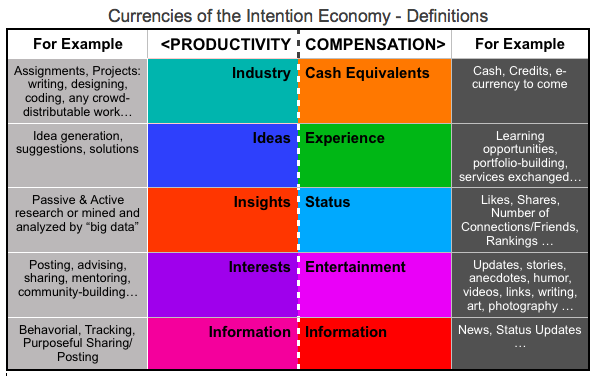
The platform can automate the manner in which the opportunity is represented — just as say Facebook and LinkedIn do for advertising now. The exchange need not be rigid. The offerer can outline options and compensation in the scope of the assignment. The member can choose which currency to accept in exchange for fulfilling that assignment. Perhaps the exchange is made for dollars, bitcoin, credits, etc. Perhaps the work is done in exchange for seeing content without advertising!
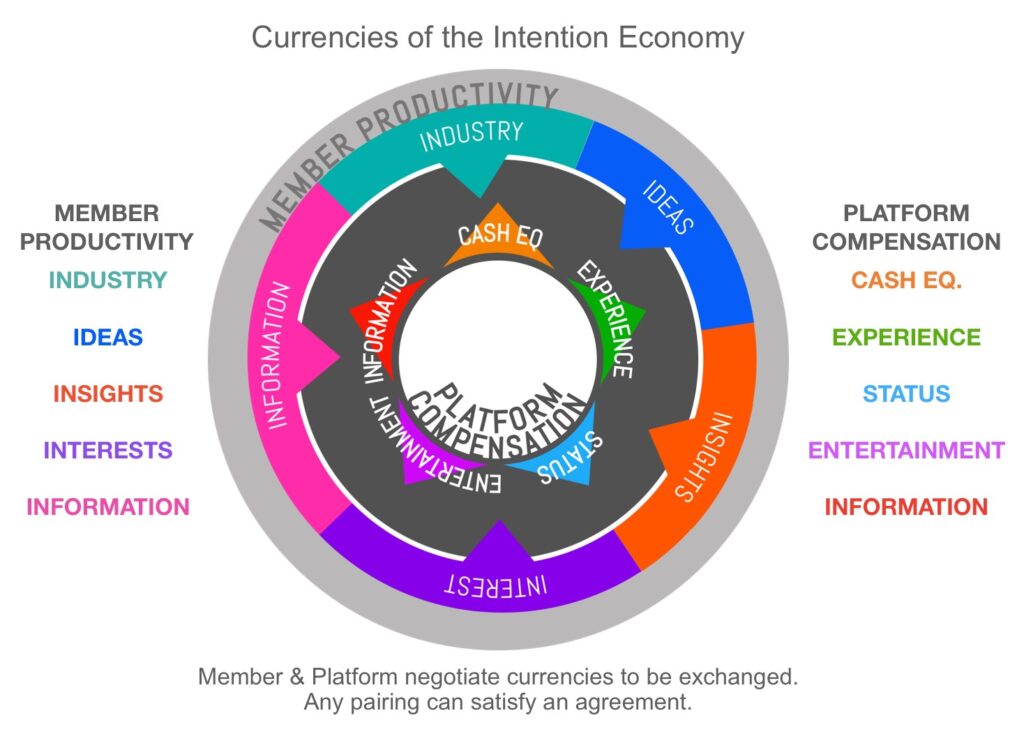
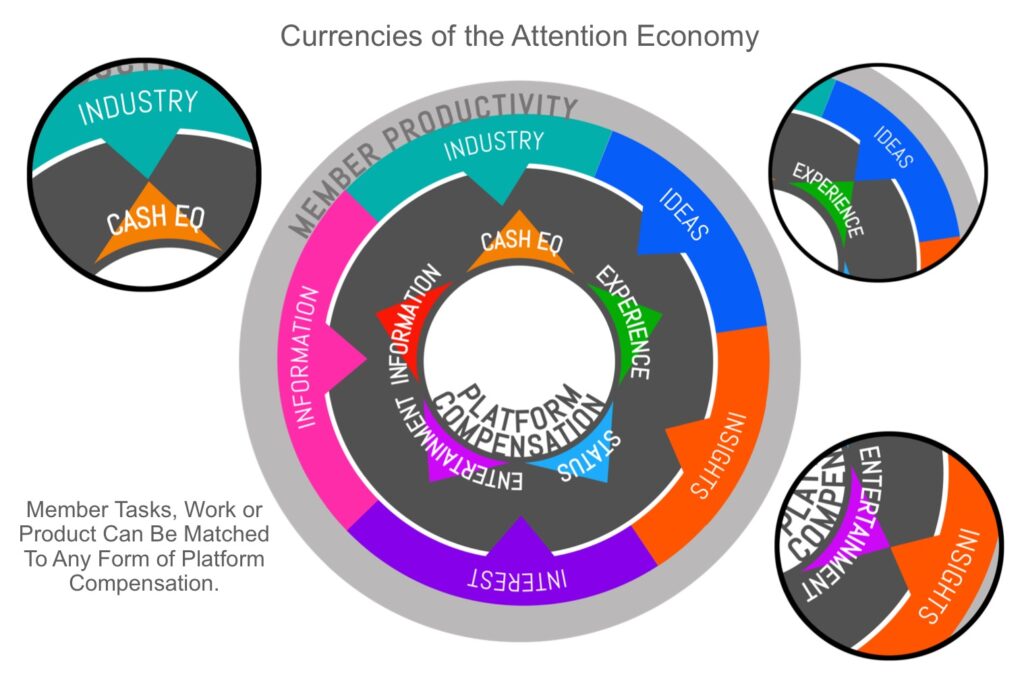
The Concept of Distributed Work Is Already Proven.
There are business models who are operating outside of “free.” Idea generation is already proving to be a viable type of distributed work. Consider Betterific. It operates as a kind open platform for people to simply post ideas. But it also operates on the enterprise level. It is competitive, but contributors can earn cash payouts typically in the form of Amazon gift cards.
Of course, there are globally populated platforms for micro-tasks, such as coding, served up to “crowds” as in Worklist.Net, traceable back to Second Life’s Phillip Rosedale and “Coffee and Power.” Of course, there is Amazon Mechanical Turk. There are also creative platforms like 99designs and fiverr. To be transparent, this author is involved in a crowd or work distribution platform, Boom Ideanet. Each of these businesses leverage free agent talent — and each assumed the obligation of amassing its “work force.”
In social networks, the “workers” are already assembled, on a heretofore unimaginable scale, with far deeper, wider data collection technology. Yes, the platforms were established for sharing. They began as free. But however free at the beginning, at some point there must be monetization to continue as a business, to continue serving up the content the eyeballs “demand” and the advertising the business model requires.
Who wouldn’t agree that only a small percentage of the advertising has value, regardless of how successfully personalized and targeted the filtering algorithm is. The bulk of advertising is distraction. There must be a saturation point at which membership falls off.
Hosting “work opportunity” may be welcome. The algorithm could identify sets of free agents based on current info. Or it could even provide a profile tool where a member select or confirm areas of interest, skills, disciplines, experience. For those who prefer to endure the advertising, the platform can easily have an off-button: “I’ll accept ads. Don’t show me work.” Facebook could easily set up a test and allow members to click a button that says, “Hide the ads. Show me opportunities.”
Let’s Work For Each Other. Members. Businesses. Neighbors. Networks.
The reality is this: an opportunity to “work for each other” as civilized human beings (Mr. Ridley) can be served up for consideration in the social network of doing. Terms are transparent, negotiated (possibly) and agreed to. Or not. The ask may not have been appealing, the member may not have had capacity or interest, the compensation may not have been agreeable. Or it may have matched all those criteria and the work is performed. It’s that simple. Reciprocity is added back into the exchange. Reboot the currencies. Welcome transparency. Create a virtuous cycle.
The work served up needn’t be from some monolithic business. It could be from a small business, a start-up, a neighbor. Just as anyone can post an ad in Facebook with a credit card and a bit of technical savvy, anyone could post a task and invite hand-raising … with a credit card. Every party benefits, not just the social platform, but the person or business who needs the work done and the member accepting the responsibility of doing that work. It’s a new take on what Faris Yakob (@faris) calls “paid attention.”
The internet has long promised to undo the unintended consequence of television: a passive, spectator-pleasing world. Indeed, social networks permit participation well beyond clicking the remote. There is interaction, but as far as social network hosts are concerned, that interaction has been defined as just another kind of clicking. On advertising and links. Is that all we want from this expansive new connected experience?
If we can evolve social networks of sharing, make them social networks of doing, the internet can deliver on its promise: replace passivity with activity; turn spectators into players, convert observers into actors. After all, what good is a network if the net doesn’t do work?
Social Networks Of Doing: It’s time to put the networks to work. Facebook, Mark Zuckerberg @finkd, Microsoft/LinkedIn, @satyanadella! Let’s do this.
Note: From an HBR interview with Doc Searls: “Well, the intention economy is an end state. I see a lot of things called the “fill in the blank economy.” This topic, among others, is alive here at what is still essentially the frontier of the digital age. One day, there were will be fewer labels to wrangle. The above argument begins with “social networks of doing.” The goal is to move the discussion beyond social networks of sharing. But finally – and it does so without any permission from Doc Searls – the idea of “doing” would actually become an active part of The Intention Economy – a world where the consumer plays a far more active, intentional (rather than incidental) role.
The above is Part 2 of We Have Social Networks of Sharing. It’s Time To Create Social Networks of Doing.
Graphics by David Butterfield
Recent Comments